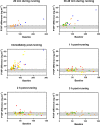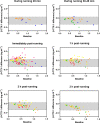P1NP and β-CTX-1 Responses to a Prolonged, Continuous Running Bout in Young Healthy Adult Males: A Systematic Review with Individual Participant Data Meta-analysis
- PMID: 37725246
- PMCID: PMC10509102
- DOI: 10.1186/s40798-023-00628-x
P1NP and β-CTX-1 Responses to a Prolonged, Continuous Running Bout in Young Healthy Adult Males: A Systematic Review with Individual Participant Data Meta-analysis
Abstract
Background: Circulating biomarkers of bone formation and resorption are widely used in exercise metabolism research, but their responses to exercise are not clear. This study aimed to quantify group responses and inter-individual variability of P1NP and β-CTX-1 after prolonged, continuous running (60-120 min at 65-75% V̇O2max) in young healthy adult males using individual participant data (IPD) meta-analysis.
Methods: The protocol was designed following PRISMA-IPD guidelines and was pre-registered on the Open Science Framework prior to implementation ( https://osf.io/y69nd ). Changes in P1NP and β-CTX-1 relative to baseline were measured during, immediately after, and in the hours and days following exercise. Typical hourly and daily variations were estimated from P1NP and β-CTX-1 changes relative to baseline in non-exercise (control) conditions. Group responses and inter-individual variability were quantified with estimates of the mean and standard deviation of the difference, and the proportion of participants exhibiting an increased response. Models were conducted within a Bayesian framework with random intercepts to account for systematic variation across studies.
Results: P1NP levels increased during and immediately after running, when the proportion of response was close to 100% (75% CrI: 99 to 100%). P1NP levels returned to baseline levels within 1 h and over the next 4 days, showing comparable mean and standard deviation of the difference with typical hourly (0.1 ± 7.6 ng·mL-1) and daily (- 0.4 ± 5.7 ng·mL-1) variation values. β-CTX-1 levels decreased during and up to 4 h after running with distributions comparable to typical hourly variation (- 0.13 ± 0.11 ng·mL-1). There was no evidence of changes in β-CTX-1 levels during the 4 days after the running bout, when distributions were also similar between the running data and typical daily variation (- 0.03 ± 0.10 ng·mL-1).
Conclusion: Transient increases in P1NP were likely biological artefacts (e.g., connective tissue leakage) and not reflective of bone formation. Comparable small decreases in β-CTX-1 identified in both control and running data, suggested that these changes were due to the markers' circadian rhythm and not the running intervention. Hence, prolonged continuous treadmill running did not elicit bone responses, as determined by P1NP and β-CTX-1, in this population.
Keywords: Bone markers; Bone remodelling; Exercise; Inter-individual variability; Proportion of response; Running.
© 2023. Springer Nature Switzerland AG.
Conflict of interest statement
All authors declare no competing interests relevant to the content of this review.
Figures





Similar articles
-
The Bone Biomarker Response to an Acute Bout of Exercise: A Systematic Review with Meta-Analysis.Sports Med. 2022 Dec;52(12):2889-2908. doi: 10.1007/s40279-022-01718-8. Epub 2022 Jul 23. Sports Med. 2022. PMID: 35870108
-
Effect of carbohydrate feeding on the bone metabolic response to running.J Appl Physiol (1985). 2015 Oct 1;119(7):824-30. doi: 10.1152/japplphysiol.00241.2015. Epub 2015 Aug 6. J Appl Physiol (1985). 2015. PMID: 26251510 Free PMC article.
-
Bone turnover following high-impact exercise is not modulated by collagen supplementation in young men: A randomized cross-over trial.Bone. 2023 May;170:116705. doi: 10.1016/j.bone.2023.116705. Epub 2023 Feb 16. Bone. 2023. PMID: 36804484 Clinical Trial.
-
The influence of acute exercise on bone biomarkers: protocol for a systematic review with meta-analysis.Syst Rev. 2020 Dec 12;9(1):291. doi: 10.1186/s13643-020-01551-y. Syst Rev. 2020. PMID: 33308281 Free PMC article.
-
Bone turnover markers in children and adolescents with type 1 diabetes-A systematic review.Pediatr Diabetes. 2019 Aug;20(5):510-522. doi: 10.1111/pedi.12853. Epub 2019 May 22. Pediatr Diabetes. 2019. PMID: 30941847
Cited by
-
Influence of Menstrual Cycle and Oral Contraceptive Phases on Bone (re)modelling Markers in Response to Interval Running.Calcif Tissue Int. 2024 Oct;115(4):382-392. doi: 10.1007/s00223-024-01259-4. Epub 2024 Jul 27. Calcif Tissue Int. 2024. PMID: 39066926 Free PMC article.
-
The comparison of serum bone-turnover markers in different stage of chronic kidney disease and the associated impact of intradialytic cycling in patients with end-stage renal disease.Aging (Albany NY). 2025 Jan 14;17(1):217-231. doi: 10.18632/aging.206177. Epub 2025 Jan 14. Aging (Albany NY). 2025. PMID: 39812596 Free PMC article.
References
Publication types
LinkOut - more resources
Full Text Sources

